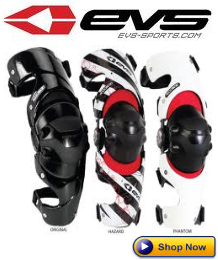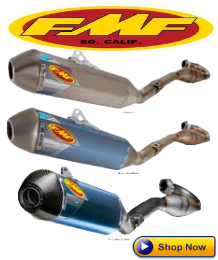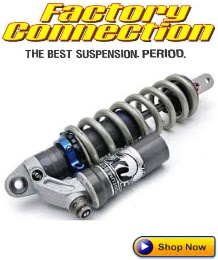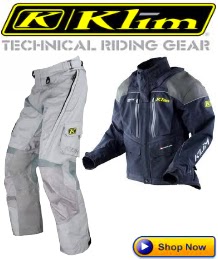TRICK TANK AIR STAND
15:52
Stand
WHAT IS IT? A bike stand that doubles as a small air tank to make filling tires and transportation to the track easier.
WHAT’S IT COST? $139.95--(704) 376-1320 or www.tricktank.com.
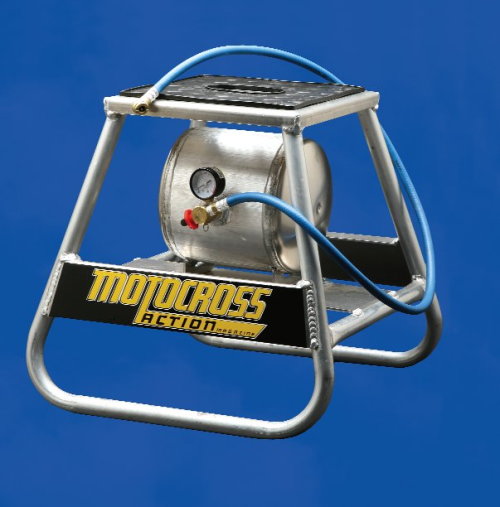
WHAT’S IT DO? Believe it or not, your bike’s performance relies heavily on the amount of air that you put in your tires. That’s why it’s important to check your tire pressure. The average Joe fills his tires with a bicycle tire pump or one of those cigarette lighter socket compressors. The fancy guys carry an air tank. The plus of an air tank is that you don’t wear yourself out pumping away or run your battery down trying to get your tire pressure to 40 pounds to pop the bead. The downside of an air tank is that it takes up space in the vehicle and the regulator is prone to damage should the tank break loose in the bed of your truck.
Enter the Trick Tank Air Stand. It kills two birds with one stone. Not only is it a bike stand, but it also has an attached air tank on the base of the stand. With the Air Stand you no longer have to worry about taking a stand and a tire pump to the track, because it’s an all-inclusive product.
WHAT STANDS OUT? Here’s a list of things that stand out with the Trick Tank Air Stand.
(1) Stand. The wide Air Stand is made out of aluminum. The stand is not remarkable in design and shares virtually all its dimensions with similar aluminum stands. It has a wide footprint, which provides a firm base for your motorcycle, and is tall enough to get the wheels off the ground. As for the air tank tucked underneath the deck of the stand, it can be removed with four bolts. Hence, you can use the stand and the air tank separately. With or without the air tank attached to the stand you will not be able to flip the stand over and put your gas can into the underside of the stand during truck transport.
(2) Air tank. The main attraction to the Air Stand is its air tank, which can hold a maximum of 125 psi of air. A compressor is needed in order to fill the smallish tank, but once full, it can fill upwards of ten tires (to 12 psi). Depending on the psi of the compressor that you use to fill the tank, it can takes several minutes to fill it up (and most likely you will not get it anywhere near 125 psi at the gas station). The three-foot hose works great for filling the tires while the bike is on the Trick Tank stand, but filling a friend’s bike means that he has to move in close and jockey for position. Some MXA testers elected to remove the tank from the stand and use it separately.
(3) Options. The Air Stand comes with a choice of six different decals (Suzuki, Kawasaki, KTM, Honda, Yamaha and Team Trick Tank). These decals, which are placed on each side of the stand, do not cost extra. You can also pick between six color rubber stand tops (red, orange, yellow, black, green, and blue).
(4) Place of manufacture. The Trick Tank Air Stand is made in Charlotte, North Carolina.
WHAT'S THE SQUAWK? This is a basic idea. Maybe next year there will be a barbecue pit/bike stand.
Boyesen Power X-Wing Intake Tract
15:51
power
BOYESEN POWER X-WING INTAKE TRACT

WHAT IS IT? Intake tract winglets have been around for decades. Do you remember Swirl-Up, Power Now, Dial-A-Jet, Tornado and Intake Twister? The Boyesen Power X-Wing is designed to increase power by improving airflow through the carb.
WHAT’S IT COST? $129.95— (800) 441-1177 or www.boyesen.com.
WHAT’S IT DO? Most people believe that an internal combustion engine is an explosive device—where fuel is lit off much like fireworks on the Fourth of July. Not true! Motorcycle engines are air pumps. Air is drawn in, compressed by force, expanded by combustion and expelled out the exhaust. Contrary to popular opinion, there is no explosion. The engine processes air, mixes it with fuel and burns the air/fuel mixture in a very orderly process. Once you understand how an internal combustion engine works, you can understand that the transition of air, from the airbox to the exhaust stinger, is all important. Nothing matters as much in the production of horse-power as the maximization, control and flow of air.
The Boyesen Power X-Wing works like an airplane wing. It takes a given volume of tumbled air and straightens it out. The goal is to achieve laminar flow. Laminar flow is the smooth, uninterrupted flow of air over the contour of a wing. The Power X-Wing reduces drag at the air’s boundary layer, reduces surface friction drag, equalizes the pressure gradient and increases air velocity.
That is a lot of techno-mumbo-jumbo, but what it means is that the Boyesen Power X-Wing is designed to increase air velocity--and, when air velocity increases, power increases.
WHAT STANDS OUT? Here's a list of things that stand out with the Boyesen Power X-Wing.
(1) Performance. In the saddle every test rider felt increased throttle response at low rpm, a smoother transition from the low-end to the midrange and a more flexible powerband across the range. Everything feels crisper and, best of all, the dips in the power curve are ironed out. The power is not only improved, but it becomes seamless from bottom to top. We tested the original Powerwing several years ago and liked it, but didn’t see any increase in power on the dyno. Not so with the new Power X-Wing (which is substantially larger and has an additional vertical airfoil that the original didn’t have). It gained one horsepower off the bottom up to 8000 rpm, but it is obvious that the big gain is in torque.
(2) Powerband. The increase in throttle response and improved transition paid its biggest dividends with Vet, Novice and Intermediate riders, because they spend more time working off the bottom.
(3) Mounting. The Boyesen Power X-Wing mounts inside the rubber air boot instead of inside the carb throat. The MXA wrecking crew liked this for three reasons: (a) It made installation as easy as pulling the air boot back and sticking the Power X-Wing in. (b) The clumsy unaerodynamic shape of the air boot is where the greatest improvement can be made in airflow. Trying to fix it at the carb throat is too little, too late. The X-Wing is located in the perfect place. (c)By putting the device in the air boot, the venturi size of the carb throat is not reduced by the thickness of the metal.
(4) Added test. Eyvind Boyesen believes in his products, and as the MXA gang was working with him on the Power X-Wing test on our YZ450F and RM-Z250, he mentioned that it worked even better on a Harley-Davidson. We called his bluff and put one in every Harley that the MXA gang has (2006 Street Glide, 1997 Sportster 883, 2005 Electra Glide FLHT and 1948 Panhead with an S&S carb), Shock! It worked. The jetting was improved, the idling smoothed out and power was improved noticeably.
WHAT'S THE SQUAWK? At $129.95, the aluminum wing-thing is expensive, but you aren’t buying the aluminum as much as the testing that goes into the shape of the wings.
DR.D 2008-2009 Yamaha YZ450F Exhaust System
15:50
yamaha
WHAT IS IT? An exhaust system that will perk up the detuned 2008 and 2009 Yamaha YZ450F.
WHAT’S IT COST? $879.95 (Ti/carbon), $779.95 (Ti/Ti), $679.95, (stainless/carbon) and $549.95 (stainless/aluminum)--(951) 808-1114 orwww.dubachracing.com. 

WHAT’S IT DO? If you own a 2008-’09 Yamaha YZ450F you know that Yamaha’s engineers seriously detuned the YZ-F. Why did they cork up the YZ450F powerband? Two reasons:
(1) Yamaha wanted to make the 450cc four-stroke easier to ride for the mass majority of riders.
(2) Yamaha wanted to reduce sound and test the worthiness of their unique waffle-cone mechanical muffler. The muffler uses cone-shaped diffusers to reduce the energy of the engine’s pulses. The results of Yamaha’s two-prong power/sound program are a one decibel reduction in sound, nine ounce weight savings and, unfortunately, a five-horsepower loss at 6000 rpm.
It will come as no surprise that the MXA wrecking crew felt that Yamaha made a mistake. We applaud their sound reduction efforts, but believe that Yamaha could have achieved the same thing without costing the YZ450F most of its low-to-mid power. Luckily, it is easy to get back the power that Yamaha lost with an aftermarket exhaust system. That is where DR.D comes in. DR.D stands for Dubach Racing & Development and headed by Yamaha’s chief test rider Doug Dubach.
WHAT STANDS OUT? Here’s a list of things that stand out with the DR.D 2009 Yamaha YZ450F exhaust system.
(1) Performance. Building a better exhaust system for the 2009 YZ450F is like shooting fish in a barrel. Virtually any straight-through muffler will eliminate the stocker’s corked-up feel. But, Doug Dubach didn’t stop there. As you would expect from the man who did the initial development work on all of Yamaha’s four-strokes, he knew better than anyone else what the YZ450F needed. Doug’s goal was not to make the YZ450F into a fire-breathing dragon, but to make it better everywhere. Starting with throttle response, through a strong midrange and a virtually seamless top end, the DR.D exhaust was amazing. It’s not just better than the stock YZ450F muffler, but better than we expected overall.
(2) Material choices. DR.D pipes are available in four different material choices: Titanium pipe with carbon fiber muffler, titanium pipe with titanium muffler, stainless pipe with carbon fiber muffler and stainless pipe with aluminum muffler. All DR.D mufflers come with magnesium end caps. If you are asking for our advice, we recommend the stainless/aluminum system. It offers the same performance as the high-priced spreads, but at a price that is several hundred dollars less. If weight is an issue, go with the Ti/Ti system. The carbon fiber muffler is lighter, but MXA never recommends carbon fiber mufflers. They have such a short lifespan that they aren’t reliable enough for us to suggest that racers spend money on them.
(3) Weight. DR.D’s Ti/Ti and Ti/carbon pipes are one pound, eight ounces lighter than the stock Yamaha YZ450F system. Their $330 less expensive stainless/aluminum system weighs the same as the stock exhaust.
(4) Good stuff. Things we like about the DR.D design are that the perf core is welded to the mid-pipe (this makes it easier to repack), the head pipe flange is super sturdy (we have problems on some pipes with their flanges), the end cap is magnesium (and comes with a spark arrester), no springs are used on the DR.D pipe (it uses the factory’s construction techniques) and DR.D offers a $50 quiet core insert that lowers the sound to current mandated levels.
WHAT’S THE SQUAWK? This is a 99dB muffler system. That makes it considerably louder than the stock 96.7 stock muffler. Additionally, in less than ten hours we noticed brown burn marks on the inside of the muffler can…a sure sign that it needs to be repacked.
Pro Circuit RM-Z250 T-4 GP System
15:50
pro circuit
INSIDE THE PRO CIRCUIT T-4 GP RM-Z250 PIPE
WHAT IS IT? The Suzuki RM-Z250 (2007, 2008 and 2009) has a potent low-to-mid powerband. The Pro Circuit T-4 GP pipe makes it more of a mid-and-up engine.
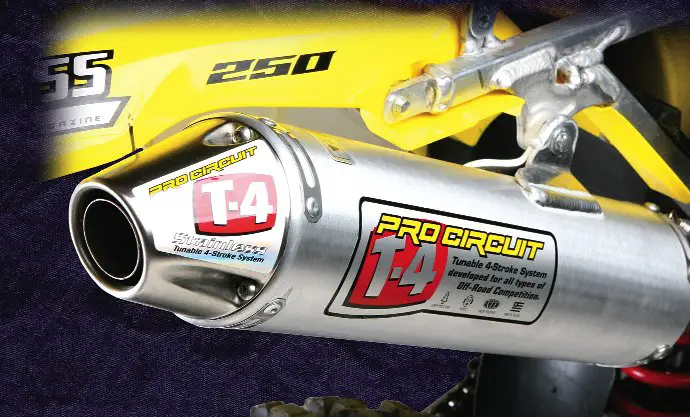

WHAT’S IT COST? $749.95 T-4 (stainless), $899.95 Ti-4 (titanium)— (951) 738-8050 .
WHAT’S IT DO? Team Suzuki rider Ryan Dungey runs a Pro Circuit pipe on his works Suzuki RM-Z250. When a factory team chooses to use off-the-shelf pipes from an aftermarket supplier, that is a strong endorsement—strong enough for the MXA wrecking crew to order a Pro Circuit T-4 GP system for our 2008 Suzuki RM-Z250.
WHAT STANDS OUT? Here’s a list of things that stand out with Pro Circuit’s Suzuki RM-Z250 Ti-4 GP System.
(1) Performance. No other 250 four-stroke is as good off the bottom as the RM-Z250. The RM-Z250 bursts out of corners and pulls hard through the midrange. If the RM-Z250 has a flaw, it is that the engine hangs and flattens out from 10,000 to 12,000 rpm. It revs, but it doesn’t pull. Thankfully, the Pro Circuit T-4 GP system provides top-end in spades. This pipe makes the RM-Z250 a gear better in every situation. Corners that you were straining in second to get to can be rocketed into in third gear with the T-4 GP pipe. It adds a healthy dose of top end and doesn’t hurt the bottom-to-mid one iota.
(2) Horsepower. From the very bottom to 7200 rpm, the Pro Circuit pipe and stock pipe are in a dead heat. From 7200 rpm on up to the 13,200 rpm rev limiter, the Pro Circuit pipe is one horsepower better. The peak power on the stocker is 35.9 horsepower, while peak on the Pro Circuit pipe is 36.9 ponies.
(3) Torque. Pro Circuit’s torque curve is a match for its horsepower curve. Starting at 7200 rpm, the Pro Circuit pipe makes and keeps a one-half foot-pound advantage over the stocker.
(4) Over-rev. The biggest weakness of the stock exhaust system is that it goes flat on the upper fringes of the rpm curve. In fact, there is a serious dip in the stock curve at 12,000 rpm (where horsepower drops off significantly). With the Pro Circuit pipe, the dip was erased and the top-end over-rev was significantly improved.
(5) Fit. Pro Circuit uses the same style head pipe flange as Suzuki, but adds two springs for more security. We didn’t like the springs (since Suzuki didn’t need them). The rest of the pipe needs a little muscle to squeeze through the RM-Z’s Delta Box chassis.
(6) Prices. Pro Circuit offers four versions of the RM-Z250 exhaust system. The titanium Ti-4 full system (head pipe and muffler) costs $899. The stainless steel T-4 full system retails for $749. The Ti-4 and T-4 have the exact same dimensions and performance; the extra $150 is for the lighter weight of the titanium. Additionally, the slip-on systems (without the head pipe) are available in both Ti ($525) and stainless ($425).
(7) Place of Manufacture. Pro Circuit’s Ti-4 exhaust is manufactured in Corona, California.
WHAT’S THE SQUAWK? Apart from leaning out the fuel screw, we had no squawks. Given our druthers, we opt to run the stainless steel system instead of the titanium system. Why? They run the same, feel the same and we think that the stainless version is more durable. Not to mention much cheaper.
Fly Formula Helmet
15:49
helmet
INSIDE THE FLY FORMULA HELMET
WHAT IS IT? A top-of-the-line motocross helmet from Fly Racing.
WHAT IS IT? A top-of-the-line motocross helmet from Fly Racing.

WHAT’S IT COST? $439.95--(877) 359-2946 or www.flyracing.com.
WHAT’S IT DO? New helmets enter the market in machine gun-like fashion. There is a new helmet introduced to the public every month. It started with the “Shoei clone” era more than a decade ago and has continued unabated ever since. Over time, the original Shoei clone marketeers got braver and drifted away from Xerox copies of the Shoei VFX. Once they stepped out of the shadow of Shoei with their own designs, the market exploded.
Fly Racing was never guilty of copying the Shoei VFX for two reasons: (1) Fly wasn’t a player in the helmet biz during the height of the clone wars, and (2)Fly’s designer Jerry Lathrop has too much pride to copy. Lathrop spent two years working on the aesthetics package of the new Fly Formula helmet. It not only boasts a number of features never before seen on a helmet, but it also breaks the $400 barrier (a first for Fly). Fly’s intentions are clear—the Formula is designed to attract the high-end attention of Shoei and Arai buyers.
WHAT STANDS OUT? Here’s a list of things that stand out with the Fly Formula helmet.
(1) Fit. There are several key areas of a helmet that can create pressure points: the forehead, crown and neck. Overall, the Formula is very comfortable, but some MXA test riders felt a minor pressure point on their foreheads. As for sizing, the helmet is spot on. As a caveat, if you fall in between sizes, then we recommend that you order the next size down.
(2) Craftsmanship. The Formula uses titanium (a material borrowed from the Troy Lee Designs SE2), carbon fiber inlets (never before used on a helmet) and stainless steel hardware. The shell is comprised of a carbon fiber/Kevlar mix that has been water jet cut for greater accuracy. The micro fiber liner is made from Drylex. It is among the softest interiors that we have come across (a shot across the bow of the Good Ship Arai). Fly also focused on air flow, evidenced by their baronial carbon fiber intakes. The Formula has 13 separate air holes incorporated into the liner. All of these features make the Formula helmet as cool as a stiff autumn breeze.
(3) Weight. As a rule a thumb, helmets that weigh at or under three pounds are considered light. The Fly Formula tips the scales at three pounds, three ounces. This is on the heavy side for a helmet with such a hefty price tag. Why isn’t it a three-pound helmet? We observed the same weight gain on the comparable Troy Lee SE2 helmet and feel that the titanium, stainless and carbon fiber pieces are responsible for the extra three ounces.
(4) Safety. Fly uses two different foam densities in the lining of their helmet. The crown features a soft density foam (similar to the Arai VX-Pro3), while the rest of the shell is surrounded by a more dense EPS foam. Both types of foam are thick and forgiving (a definite plus for reducing serious head injuries).
(5) Options. The Formula helmet comes in two designs and five color ways. It passes Snell 2005 and DOT safety standards and is available in sizes from extra-small to extra-extra-large. Fly offers different size cheek pads to customize the fit.
(6) Place of manufacture. The Fly Formula helmet is made in China.
WHAT’S THE SQUAWK? We have two quibbles: for the price we’d like it to be lighter, and some test riders complained about a pressure point on their foreheads.
LOUDMOUTH QUICK CHANGE AIR FILTER
15:48
filter
WHAT IS IT? The Loudmouth is a CNC-machined airbox ring that replaces the stock airbox ring and air filter mount.
WHAT’S IT COST? $150.00 (Honda, Suzuki and Kawasaki), $190 (Yamaha)— (631) 445-6865 or www.loudmouthmx.com.
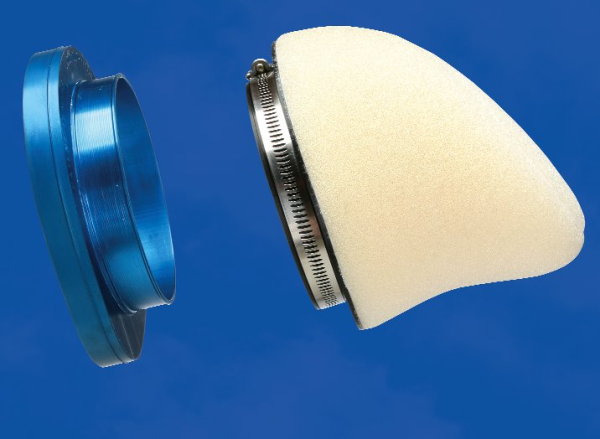
WHAT’S IT DO? For a simple air box ring, the Loudmouth air filter system has its feet in a lot of fires. It makes the air filter easier to access. It eliminates the bulky and restrictive filter cage and mounting bracket. It does away with the backfire screen (and replaces it with a fireproof foam No-Toil air filter). And it claims to increase horsepower, torque and throttle response.
The Loudmouth kit consists of a CNC-machined aluminum adapter plate that replaces the stock plastic airbox intake plate. It many ways it is similar to the aluminum plates that have been sold to eliminate leakage around the front of the air boot. The difference is that the Loudmouth goes inside the airbox housing, where it serves as a new mounting point for a No-Toil Super-Flo clamp-on filter. The filter is held in place with a large hose clamp that goes around the extended lip on the aluminum ring. To remove the No-Toil filter all you have to do is loosen the hose clamp and pull the filter out. With the LoudMouth, you eliminate both the blockading filter cage and restrictive backfire screen.
WHAT STANDS OUT? Here’s a list of things that stand out with the Loudmouth quick change air filter system.
(1) Performance. Although designed for ease of use, the Loudmouth’s airy design does have performance
benefits. The wide open intake opening allows for a larger volume of air to flow into the engine, and with no cage, wire screen or cage mounting bracket, the air is unrestricted into the carb throat. On the dyno the Loudmouth actually showed a horsepower increase, across most rpm settings. On the track, test riders felt the power increase as more transitional power across the midrange. We didn’t have to re-jet.
(2) Installation. MXA tested the Loudmouth on a 2009 Yamaha YZ450F, and thanks to the simplicity of Yamaha’s airbox design, it could be installed in less than ten minutes. It takes longer on a Kawasaki, Honda or Suzuki because their airbox rings bolt on. It is necessary to seal the plate with Hondabond or Yamabond.
(3) Air filter. Every Loudmouth system uses the same air filter whether on a CRF, RM-Z, KX-F or YZ-F. It uses a rubber lip-style filter (called a green weenie decades ago). It is easy to change and the extended lip of the Loudmouth ring makes it impossible for dirt to fall into the carb. Best of all, you don’t have to fish around with the wing nut bolt to get the filter installed.
WHAT’S THE SQUAWK? No complaints. We’d run the Loudmouth just because it makes cleaning the filter easier. The improved powerband is a bonus.
Mototek Duce Bike Stand
15:48
Stand
INSIDE THE MOTO-TEK DUCE THREE-WAY BIKE STAND

WHAT IS IT? The Moto-Tek Duce stand eliminates the need to lift your bike up after a moto.
WHAT’S IT COST? $109.95--(818) 592-0735 or www.moto-tek.com.
WHAT’S IT DO? Moto-Tek doesn’t get half the credit they deserve. There have been bike stands on the market since the late ’60s. They have come in every shape, size and configuration imaginable. From as far back as the Mark Charles Stand, inventors have been trying to come up with new ways for riders to hold their bikes up in the pits (or garage). You would think that after 40 years of brainstorming on bike stands, every thing that could have been invented would have been invented.
Imagine our surprise when we stumbled upon Moto-Tek’s totally different take on bike stands. It isn’t just a stand that you put your bike on top of, but you can also roll the front wheel into it and walk away. As an added bonus, you can put it in the front of your truck bed and use it as a wheel chock. The original Moto-Tek stand was called the 3In1-Stand. It was constructed out of powder-coated steel and retailed for $169.95. It worked very well, but was heavy, hard to ship, and not adjustable for the new breed of wide front tires.
Enter the Duce. Made from lightweight 6061-T6 aluminum, it can be broken down for shipping (lowering S&H fees) and has adjustment for wider front tires.
WHAT STANDS OUT? Here’s a list of things that stand out with Moto-Tek’s Duce stand.
(1) Center stand. When flipped up on its sturdy tripod legs the Moto-Tek Duce stand can be used as a traditional bike stand. It is the exact same height as the most popular bike stands and comes with a pressure-bonded rubber top deck (which paradoxically is sometimes not on the top).
(2) Front wheel stand. The MXA wrecking crew is lazy. When we come in from a tough moto we don’t always have the strength to lift our trusty but rusty 230-pound scoot up on the stand. That’s where the Duce’s greatest charm comes into play. Unlike any other motocross stand (save for the 3IN1-Stand), you can use the Duce stand without picking your bike up. No lifting. No grunting. And no standing there for ten minutes waiting for the strength to return to your arms. You just drive your front wheel into the front loop of the Duce stand and then walk away. It is almost idiot-proof.
(3) Hauling. The Duce is narrower than a conventional bike stand, but it has a wider stance, which means that takes up more room in your truck bed. The trick to hauling the Duce stand is to flip it against the front of your truck bed and roll the front wheel in before hooking up the tie-downs. It doubles as a wheel chock and a bed strengthener.
(4) Price. Thanks to its modular construction and simpler design, the Duce stand is $50 cheaper than the 3In1-Stand.
WHAT’S THE SQUAWK? Two quibbles: (1) When being used as a front wheel stand it is best to place it on level ground. (2) When using it as a conventional stand be sure to put the loop end away from the side you lift your bike from (typically the left side). The loop end sticks out farther than on a regular bike stand.
OHLINS TTX44 SHOCK
15:46
SHOCK
WHAT IS IT? The Ohlins TTX44 shock is the most ingenious and creative shock ever offered to the average Joe. It is built from the highest quality material with the latest in technology.
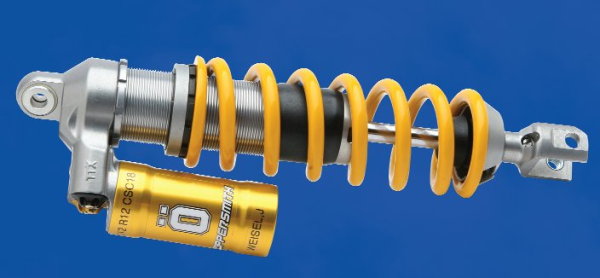
WHAT’S IT COST? $1042.00 to $1232.00 (depending on model)--(330) 724-2900 or www.ohlinsmx.com.
WHAT’S IT DO? Back in the ’70s every motocross racer budgeted to buy new shock absorbers for his trusty but rusty scoot. Ohlins, Marzocchi, Hiiesalu, Works Performance, Corte Cossa, S&W, Arnaco, Curnutt, White Power, Girling, Boge Mulholland, Fox, Bilstein and Koni were just a few of the companies that sold aftermarket suspension. It may be hard to imagine today, but 20 years ago no self-respecting racer would use stock Kayaba or Showa components.
Suddenly, the Japanese OEM producers upped their game and aftermarket shocks began to fade away from motocross; the companies that remained in business switched their focus to automobile racing, offroad trucks, road racing and vintage motocross bikes. Specialized suspension components didn’t disappear from motocross, but they became both expensive and the exclusive territory of factory riders.
Even former aftermarket and OEM supplier Ohlins produced special works shocks for factory riders. The TTX44 shock absorber was just such an item. But Ohlins, with the help of Thom Smith of Coppersmith Suspension, is making an effort to convince American motocrossers that they don’t have to be a factory rider (or have $6000 in their pockets) to get works-like
suspension.
suspension.
To give it the toughest possible test, the MXA wrecking crew asked Coppersmith to supply us with a TTX44 for our 2009 KTM 450SXF—-a bike with a troubled rear suspension history.
WHAT STANDS OUT? Here's a list of things that stand out with the Ohlins TTX44 shock absorber.
(1) Nomenclature. The TTX44 name is shorthand for the Ohlins shock’s features. TT stands for Twin Tube, the X means that the shock has both high- and low-speed compression adjusters and the 44 refers to the piston diameter. Perhaps the shock would be more accurately named the TTX44-CSC, because this shock also features Ohlins’ unique Chassis Stability Control (CSC).
(2) CSC. The CSC valve controls the bleed flow over the main piston in both compression and rebound strokes. MXA test riders used the CSC adjuster to dampen out low-speed chassis movements. The CSC valve is capable of working separately from the compression and rebound adjusters, which means a rider has an additional tool to help with chassis stability. We used it the most.
(3) Twin Tube Design. The twin tube shock body allows the gas pressure to support the low-pressure side of the piston at all times. The twin tube design allows the compression and rebound adjusters to work separately without any crossover effect.
(4) Adjustment. We loved this shock, but it took us a while to get over “adjuster trauma.” The Ohlins has a lot of adjusters (high-speed compression, low-speed compression, rebound and Chassis Stability Control) with a lot of clicks. The MXA test crew spent considerable track time learning where each clicker came into play.
(5) Performance. On our KTM 450SXF the stock shock does an adequate job of absorbing the rough edges of a track, but the Ohlins took ground control to another level. Little bumps that wouldn’t register on the KTM’s movement needle were soaked up by the super sensitive TTX44. We had never felt our stock KTM move in certain types of terrain, but test riders could feel the Ohlins shock’s constant motion leveling out the ride. In our opinion, the Ohlins shock is 30 percent better than the WP shock.
WHAT'S THE SQUAWK? The price. For that kind of money you could revalve your stock shock five times (and maybe get it right).
Suscribirse a:
Entradas (Atom)







